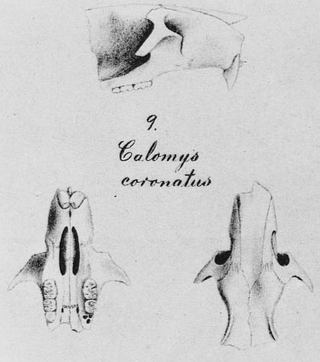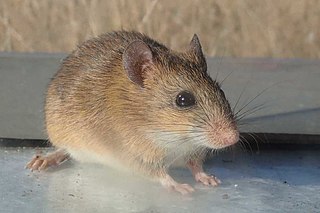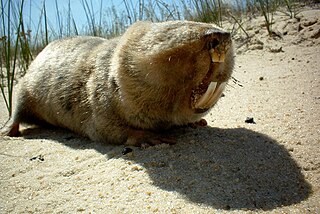
Gundis or comb rats are a group of small, stocky rodents found in Africa. They live in rocky deserts across the northern parts of the continent. The family comprises four living genera and five species, as well as numerous extinct genera and species. They are in the superfamily Ctenodactyloidea. Local people in northern Africa have always known about gundis, however they first came to the notice of western naturalists in Tripoli in 1774, and were given the name gundi mice. While they are not regarded as pests, some people hunt gundis for food.

The Chacoan mara or Chacoan cavy is a relatively large South American rodent of the cavy family. They are a close relative of the better known Patagonian mara. The Chacoan mara is the sole member of the genus Pediolagus.

Diatomyidae is a family of hystricomorph rodents. It is represented by a single living species, Laonastes aenigmamus, native to Laos in Southeast Asia. Fossil species are known from the Oligocene and Miocene of Asia and eastern Europe.
The Bolivian bamboo rat, is a species of spiny rat from South America.

Yonenaga's Atlantic spiny-rat or torch-tail spiny rat is a spiny rat species endemic to Brazil. Locally, it is known as rabo de facho. Named for Yatiyo Yonenaga-Yassuda, a cytogenetics researcher, it is considered an endangered species due to its highly restricted distribution and ongoing habitat loss. Genetic evidence shows that it diverged from its closest living relative, the hairy Atlantic spiny rat, around 8.5 million years ago, during the Late Miocene.

Euryoryzomys russatus, also known as the russet oryzomys, russet rice rat, or big-headed rice rat, is a species of rodent in the family Cricetidae. It is a member of the genus Euryoryzomys, which was split off from Oryzomys in 2006. It was first described by Johann Andreas Wagner in 1848. It is found in southern Brazil, eastern Paraguay and northeastern Argentina. It is considered a large species in its genus, with a reddish-brown coat, long tail length, and large skull. It is a terrestrial rodent, spending its time foraging for seeds, fruits, and insects. It is listed by the IUCN as least concern, although studies have shown it to be influenced by anthropogenic disturbances. Predators consist of small members of the order Carnivora.

The Tete veld aethomys or Tete veld rat is a species of rodent in the family Muridae. It is found in South Africa and Eswatini. Its natural habitats are temperate forests, shrubland, and grassland. The common name refers to the type locality, Tete, on the Zambesi River.
The thin sand rat or lesser sand rat is a species of rodent in the family Muridae. It has also been previously named the pale sand rat based on work published by Oldfield Thomas in 1925. It is found in Algeria, Libya, and Tunisia, and its natural habitats are subtropical or tropical dry shrubland and intermittent salt lakes. The thin sand rat was previously classified as a subspecies of the fat sand rat. However, morphological differences in size and coat color between the two animals, along with recent molecular evidence suggest that they are different species. The thin sand rat may be a natural reservoir for the disease leishmaniasis.

The wildlife of Libya is spread over the Mediterranean coastline and encompasses large areas of the Saharan desert. The protection of wildlife is provided through appropriate legislation in seven national parks, five reserves, 24 protected areas, two wetlands under Ramsar Convention, and also in other areas. Apart from these, there are also five UNESCO World Heritage Sites related to culture. The most important national parks are the El-Kouf National Park and Karabolli National Park. The well known nature reserves are the Benghazi Reserve and the Zellaf Reserve. The wildlife species recorded in the country are 87 mammals and 338 species of birds.

The Talas tuco-tuco is a species of tuco-tuco endemic to eastern Argentina.

The felou gundi is a species of rodent in the family Ctenodactylidae. It is monotypic within the genus Felovia.
The Sinnamary brush-tailed rat, is a species of rodent in the family Echimyidae. It is found in French Guiana, Guyana, and possibly Suriname. Its natural habitat is subtropical or tropical moist lowland forests.
The masked mouse-tailed dormouse, also called Ognev's mouse-tailed dormouse, is a species of rodent in the family Gliridae. It is found in Iran and Turkmenistan.

Speke's pectinator or Speke's gundi, is a species of rodent in the family Ctenodactylidae. It is monotypic within the genus Pectinator. It is found in Djibouti, Eritrea, Ethiopia, and Somalia. Its natural habitats are subtropical or tropical dry shrubland, subtropical or tropical dry lowland grassland, and rocky areas.

The giant blind mole-rat is a species of rodent in the family Spalacidae endemic to the North Caucasus region of Russia. It feeds on roots and tubers and lives underground in a burrow that it digs with its teeth.

The unstriped ground squirrel is a species of rodent in the family Sciuridae. It is the only member of the genus Xerus. It is found in Djibouti, Eritrea, Ethiopia, Kenya, Somalia, Sudan, Tanzania, and Uganda. Its natural habitats are dry savanna and subtropical or tropical dry shrubland.

The Cameroon scaly-tail, also referred to as the Cameroon anomalure, flightless anomalure or flightless scaly-tail, is a rodent species endemic to West Central Africa. The scientific literature has never reported observations of live individuals. The taxonomic classification of the species has been subject to recent revision.

The common gundi is a species of rodent in the family Ctenodactylidae. It is found in Algeria, Libya, Morocco, and Tunisia. The parasitic organism Toxoplasma gondii was first described in 1908 in Tunis by Charles Nicolle and Louis Manceaux within the tissues of the gundi.
Ricardo Ojeda's degu is a species of rodent in the family Octodontidae. It is found in a small portion of eastern Chile and western Argentina, being the only degu found outside of Chile. It was named after Argentine mammalogist Ricardo Ojeda.
















